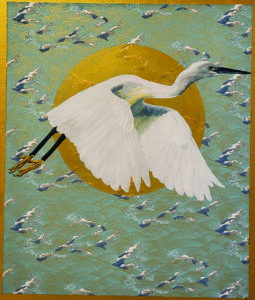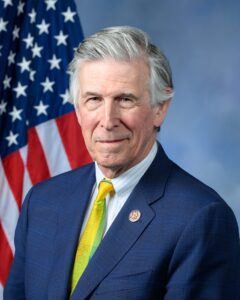The preaching and the call and response go back 150 years at Second Baptist Church off Annandale Road.
The largely African-American parishioners bore exuberant witness during a richly musical Sunday service March 18, some 50 present in person and another two dozen tuning in on monitors via Zoom. All form the modern incarnation of a community that has persevered to make its mark on greater Falls Church by giving its 75 members the feel of belonging to a large family.
“The majority are residents of Falls Church and the surrounding area,” with six members in their 90s, said Rev. Kevin Thompson Sr., stressing to a visitor from the News-Press that there is diversity among the worshippers. As minister of music and a strong-voiced soloist, Thompson tells the gathered — some in lace hats or coats and ties — others; more casual — “When second Baptist begins to pray, things happen.”
Before the service proper begins, those who come early are encouraged by deacons to share their lives’ up or down events, to offer prayers for someone in need, or merely designate a hymn or psalm for recitation. Even shy ones in the pews don’t remain quiet for long, a vivid contrast with more formal Catholic and Protestant styles.
Second Baptist at 6626 Costner Drive traces its roots to 1870, when white pastor (and abolitionist) Hiram Reed of Columbia Baptist urged Washington-based Civil War black veteran Robert Johnson to invest in Falls Church land and join the ministry. The congregation, including members of the local Henderson family, planned it in an early earthen cabin on South Washington St. They raised money to build a simple church on “Baptist Hill.” That early Second Baptist was damaged by a hurricane in 1890, but restored. A decade later, the congregation split, with some leaving with Pastor James Scott to form the Third Baptist Church, built in 1900 a block away at 2813 Annandale Rd. (That building, though still marked by its sign, is abandoned, a neighbor confirms. Property records show 2014 as the latest year for which there was a tax assessment.)

The Second Baptist loyalists, meanwhile, grew in sufficient numbers to plan a modern building. They created a foundation and raised money to purchase construction materials such as window frames, according to the church website history. A cornerstone was laid on June 22, 1922. That fall $1,020 worth of supplies were purchased from the venerable Arlington and Falls Church-based Murphy & Ames lumber company and stored in the basement of the old church until January 1924. The first service in the new structure was held July 26, 1926.
Also established was a graveyard, which contains headstones both old and recent. 19th-century black landowner James Lee, for whom the Fairfax County community center next door is named, spent time at Second Baptist.
Among the notable pastors was Wallace Earl Costner, installed in May 1935 to help Second Baptist prosper “spiritually and financially,” the history testifies. In January 2007, Rev. Samuel Barnhart Sr. was elected pastor. He continued the congregation’s involvement in the Lott Carey Foreign Mission Convention, the Baptist General Convention, the Progressive National Baptist Convention, and the Minister’s Conference of Northern Virginia.
Under Barnhart’s tenure, the church modernized its computer equipment, with a big-screen television to enhance education, and acquired 15-passenger and seven-passenger vans. Also launched were a health ministry and a dance ministry. “First Lady” Devera Barnhart edits the monthly newsletter called the Second Miler, which includes scripture, activity announcements, recipes and jokes.
Due to illness, Pastor Barnhart’s duties are being fulfilled by Thompson. “It’s funny, when I joined 30 years ago, I came as a fill-in musician while they searched for a new musical director,” said Thompson, 48 and raised in D.C. “The shared joke I say is that ‘30 years later, you guys are still looking.’”
During the March 18 service, a mic’d-up Thompson performed spiritual hymns on his keyboard to encourage participation. “There’s an emotional period at the beginning of service, an opportunity to share what God has done, and people are encouraged to trust God and share their own testimony,” he said. Yes, at times some won’t open up, “but when people are hesitant, as a musician I try to tailor the songs I sing to encourage them.”
The sermon that day was by guest minister Jarvis O. Smith from Southern Friendship Missionary Baptist Church in Maryland. Reading from the Book of John 9:6, he recounted the tale of Jesus healing a blind man and confronting skeptical onlookers. Smith invoked the word “pass” in its several senses: as in “pass the biscuits,” or pass a basketball, pass in a speeding car, and, finally, passing a panhandler without stopping to donate. He urged the congregation to be ready for opportunities for good works. “Prepare yourself for Jesus to pass by,” he said.
Second Baptist is active in the S.H.A.R.E Food network for the needy. And even before the pandemic, Thompson said, its “moneyless market” volunteers collected surplus but good-condition items from stores such as Bed, Bath and Beyond to sort and make available to the community.
The building—used regularly for weddings, memorial services, Sunday School and Wednesday Bible study—is maintained by a cleaning contractor and the trustees, who just renovated the roof. Donors to a building fund get their name on a metallic “donor recognition tree.”
Active parishioners include Teresa Earleen Washington, age 90, who recalls elementary school in the class of famed educator Mary Ellen Henderson, namesake for the Falls Church middle school. Other 90-plus devotees include Barbara Deskins, Iola Chase, Mary Murray, Claudia Furr and Tereseda Snead.
The board of trustees is led by Alotta E. Taylor, an executive at NASA who joined in 1983 on a friend’s recommendation. “I saw I could provide some core value to the Sunday School and board of trustees, who needed my skill set,” she told the News-Press. “There’s a good family atmosphere.”
Are enough young people participating to portend a healthy future? “The draw,” Thompson says, “is relevant preaching and music that meets them where they are.”












